History of Revolutions: Essential Concepts for Reading Comprehension
Revolutions mark transformative periods in history, where societal, economic, political, or technological structures undergo radical change. They are driven by the pursuit of progress, equality, and innovation but often involve conflict, disruption, and long-term consequences. RC passages on this topic typically explore causes, impacts, and historical significance. Understanding these concepts equips readers to analyze the dynamics of change across different revolutions.
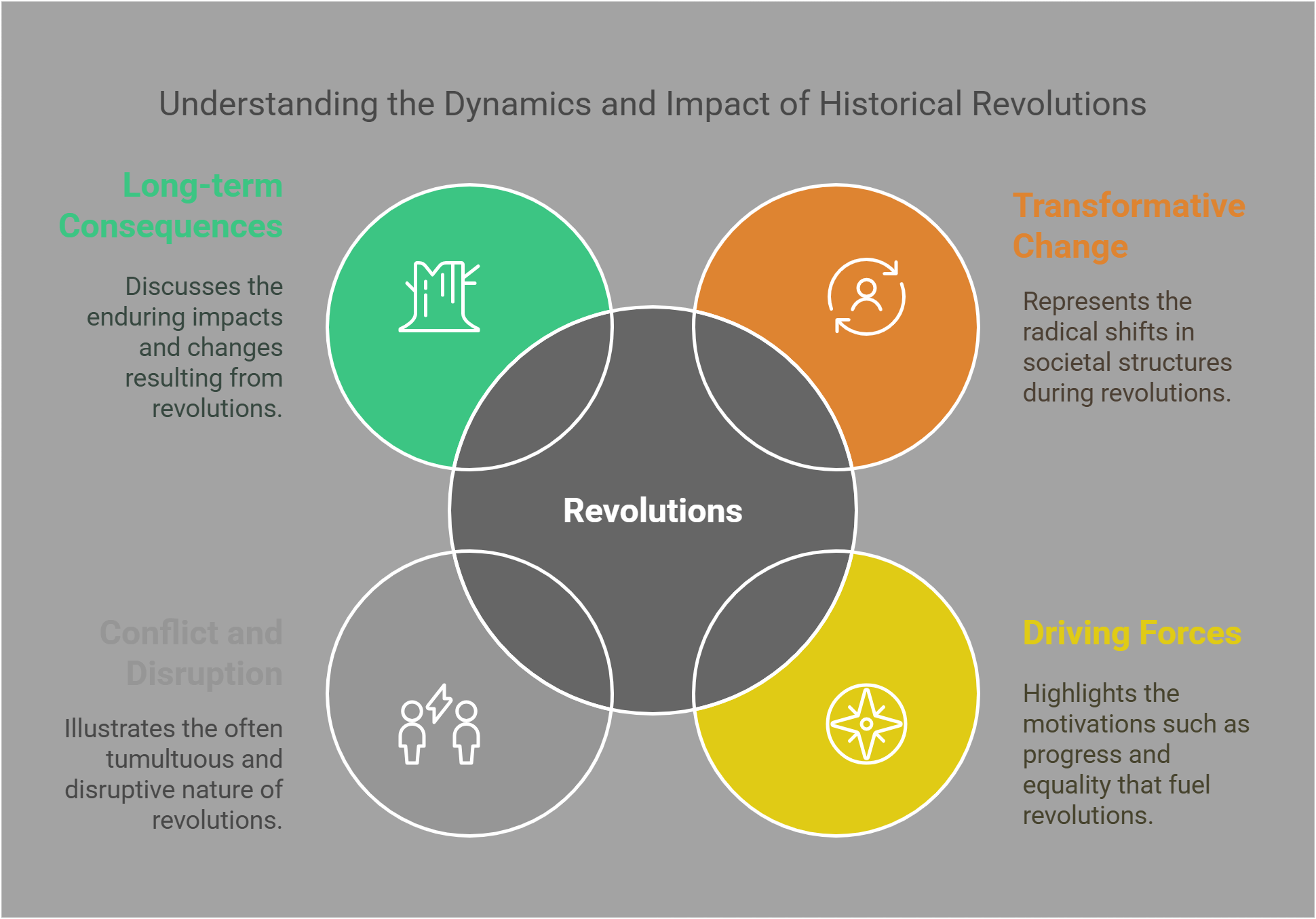
📋 Key Concepts
This guide explores the following essential concepts in the history of revolutions:
- Industrial Revolution
- French Revolution
- American Revolution
- Russian Revolution
- Green Revolution
- Digital Revolution
- Cultural Revolutions
- Political Uprisings
- Post-Revolutionary Societies
- Decolonization Movements
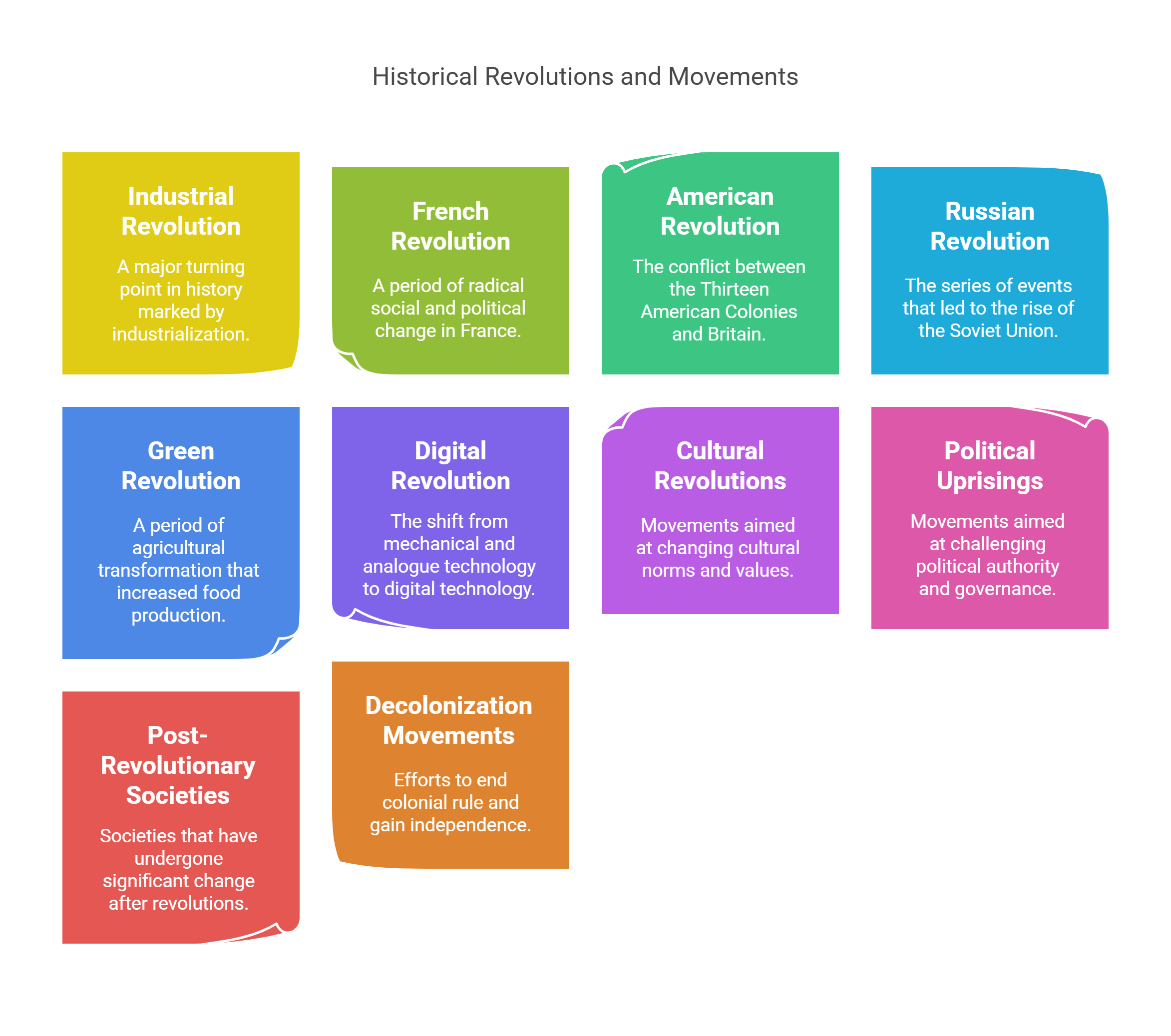
🔍 Detailed Explanations
1. Industrial Revolution
The Industrial Revolution (18th–19th centuries) transformed economies from agrarian-based systems to industrialized, mechanized ones. Originating in Britain, it spread to Europe, the Americas, and beyond, altering production methods, labor systems, and societal structures.
- Key Innovations:
- Textile Industry: The spinning jenny and power loom revolutionized fabric production.
- Steam Power: Engines powered factories, ships, and trains.
- Iron and Steel: Advances in metallurgy enabled infrastructure growth.
- Impact:
- Urbanization surged as people moved to cities for factory work.
- Social changes included the rise of the working and middle classes.
- Environmental degradation and labor exploitation emerged as challenges.
Example: The development of railways during the Industrial Revolution connected cities and spurred economic growth.
Explained Simply: The Industrial Revolution was like swapping hand tools for machines, forever changing how the world worked.
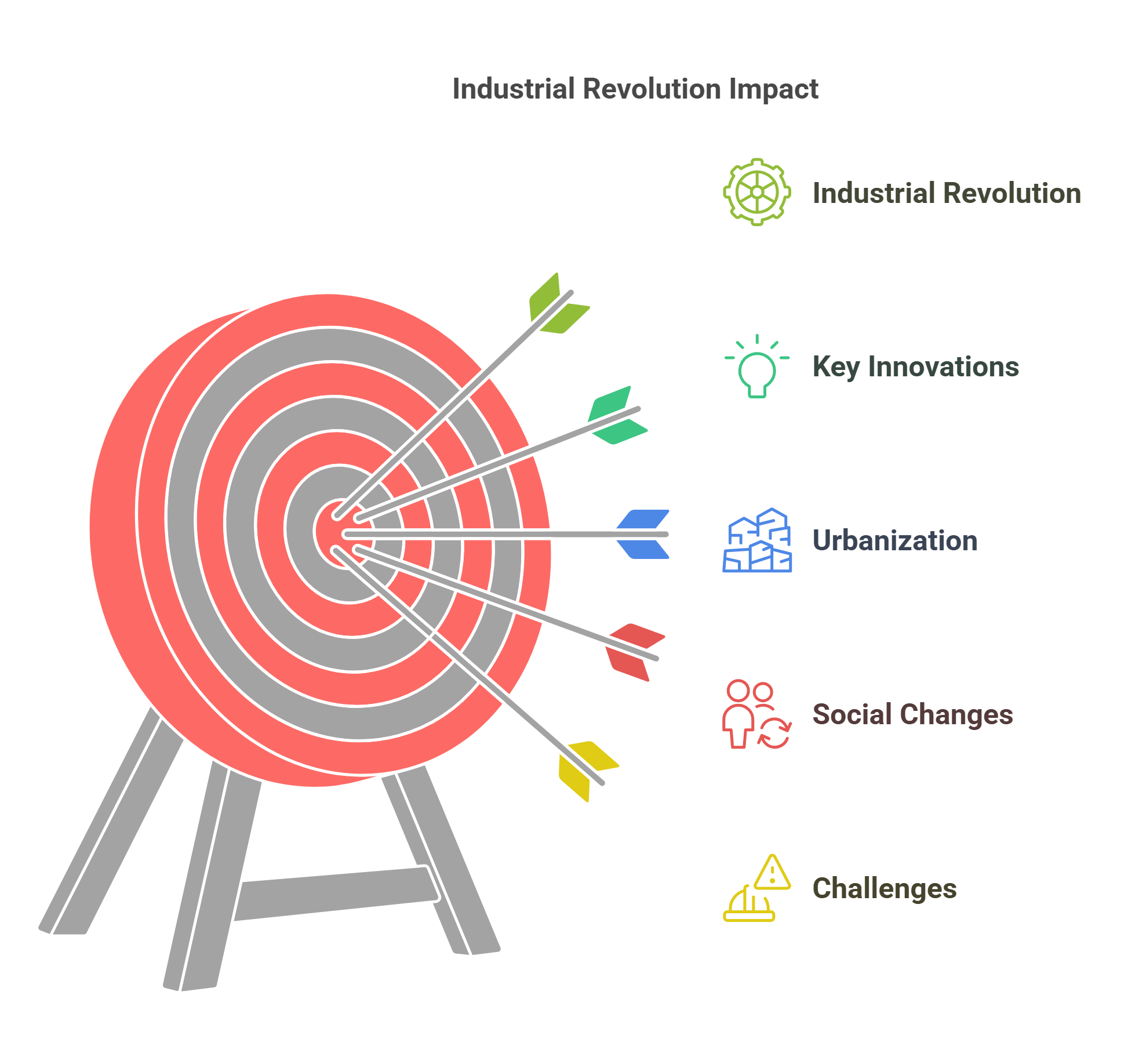
2. French Revolution
The French Revolution (1789–1799) was a period of political and social upheaval in France, driven by demands for liberty, equality, and fraternity. It overthrew the monarchy and led to the establishment of a republic.
- Causes:
- Economic hardship due to debt and food scarcity.
- Enlightenment ideas challenging monarchy and privilege.
- Inequality between the three estates (clergy, nobility, and commoners).
- Key Events:
- Storming of the Bastille (1789): Symbolized the start of the revolution.
- Reign of Terror (1793–1794): Marked by radical purges and executions under Robespierre.
- Napoleonic Era: Napoleon Bonaparte rose to power, consolidating revolutionary gains.
- Impact:
- Inspired democratic movements globally.
- Abolished feudal privileges in France.
- Paved the way for modern nation-states and legal systems.
Explained Simply: The French Revolution was like flipping the chessboard to challenge the king and create a new order.
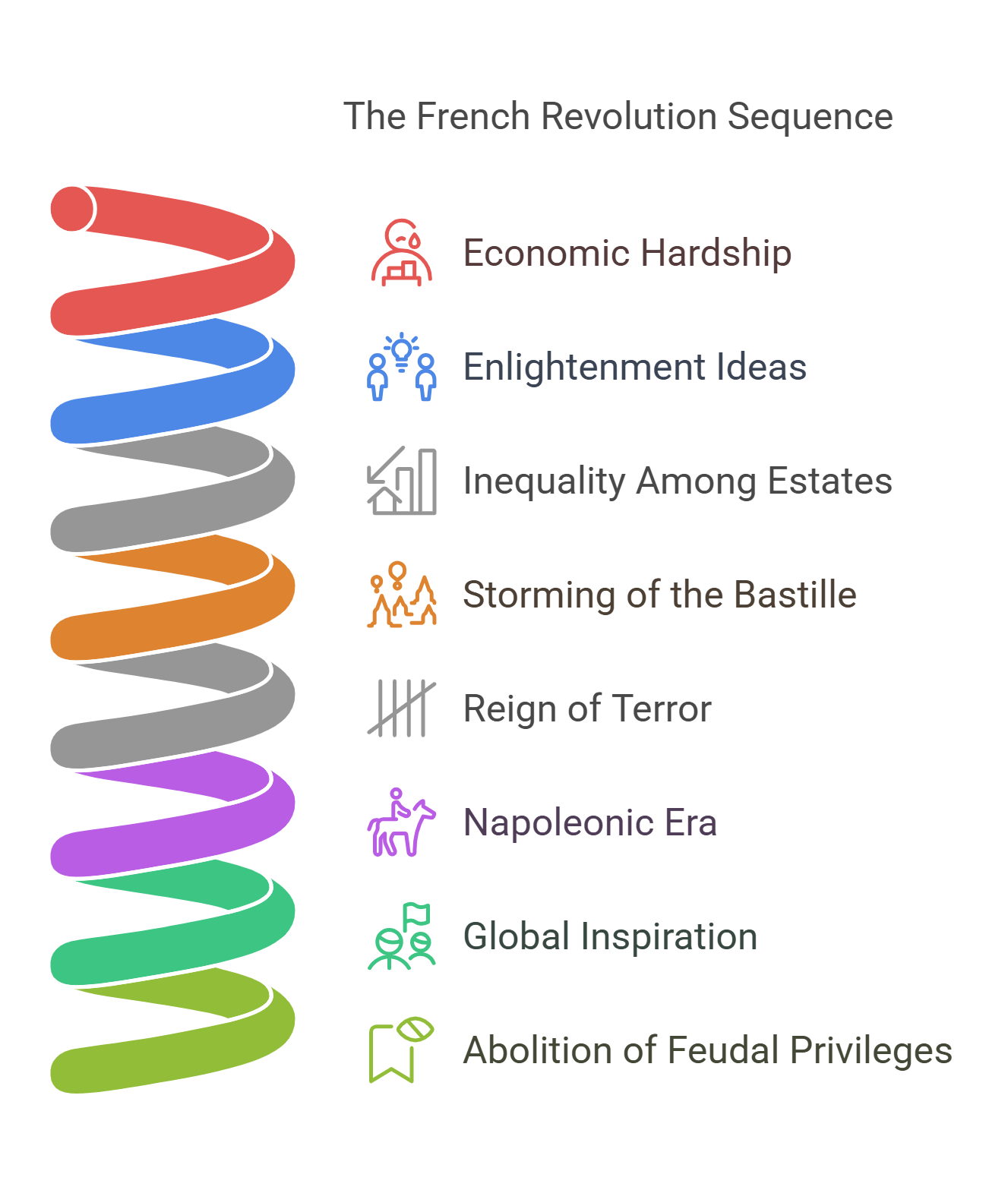
3. American Revolution
The American Revolution (1775–1783) was a colonial revolt against British rule, resulting in the creation of the United States as an independent nation.
- Causes:
- Taxation without representation (e.g., the Stamp Act and Tea Act).
- British interference in colonial self-governance.
- Enlightenment ideas emphasizing natural rights and self-determination.
- Key Events:
- Declaration of Independence (1776): Asserted the colonies’ right to self-rule.
- Battle of Yorktown (1781): A decisive victory leading to British surrender.
- Treaty of Paris (1783): Officially ended the war and recognized U.S. independence.
- Impact:
- Established the U.S. Constitution and a democratic government.
- Inspired independence movements in Latin America.
- Shifted global power dynamics.
Explained Simply: The American Revolution was like a teenager breaking free from parental control to start their own life.
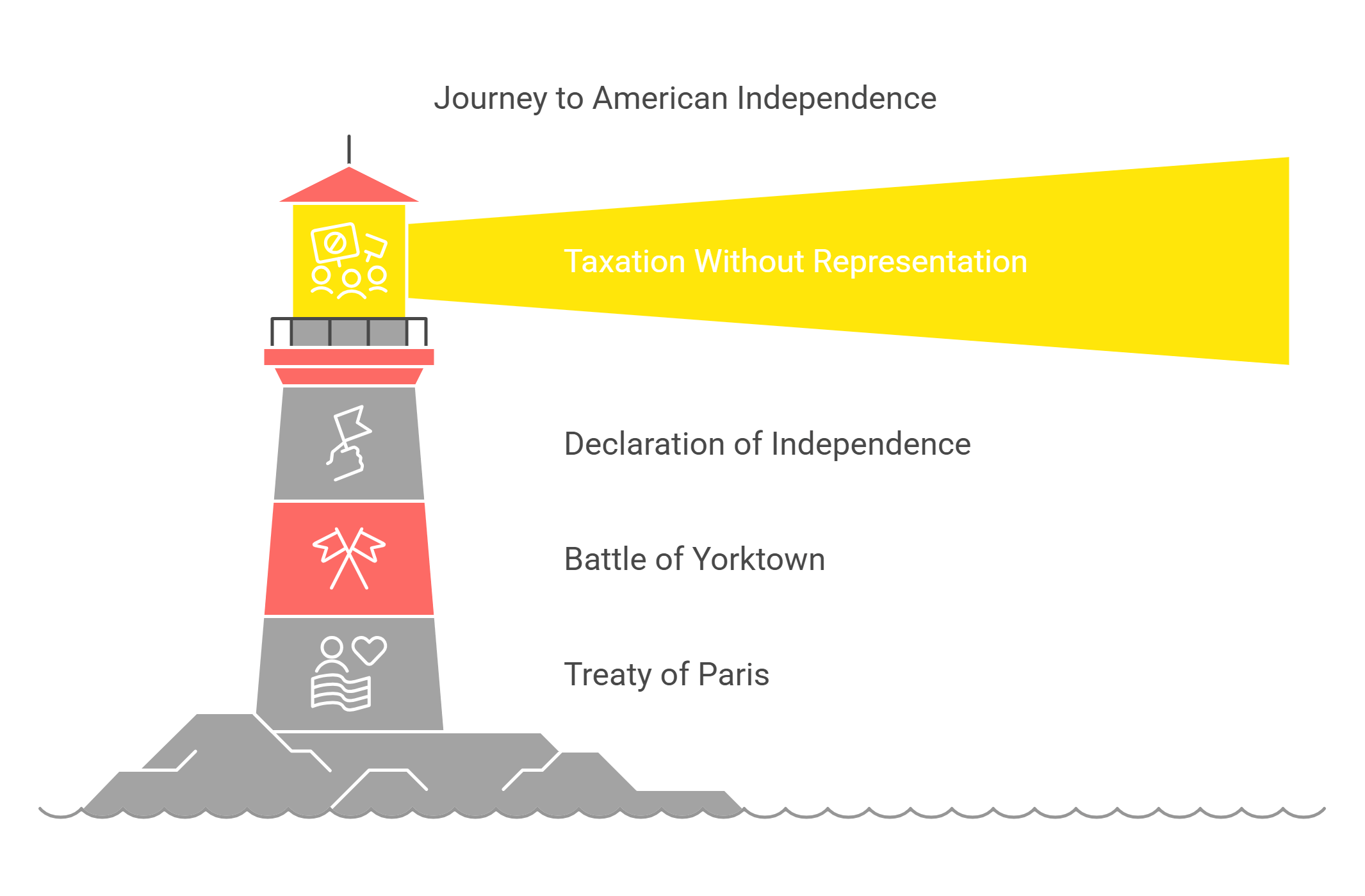
4. Russian Revolution
The Russian Revolution (1917) dismantled the Russian Empire and led to the establishment of the Soviet Union, marking a pivotal moment in world history. It was divided into two key phases: the February Revolution and the October Revolution.
- Causes:
- Widespread poverty and inequality under Tsarist rule.
- Military failures in World War I.
- Growing discontent among workers, peasants, and soldiers.
- Key Events:
- February Revolution: Overthrew Tsar Nicholas II and established a provisional government.
- October Revolution: The Bolsheviks, led by Vladimir Lenin, seized power and implemented socialist policies.
- Impact:
- Established the first communist state, influencing global politics for decades.
- Sparked ideological conflicts, including the Cold War.
- Redefined class struggle and governance models worldwide.
Explained Simply: The Russian Revolution was like replacing the old system with a radical new experiment in equality and governance.
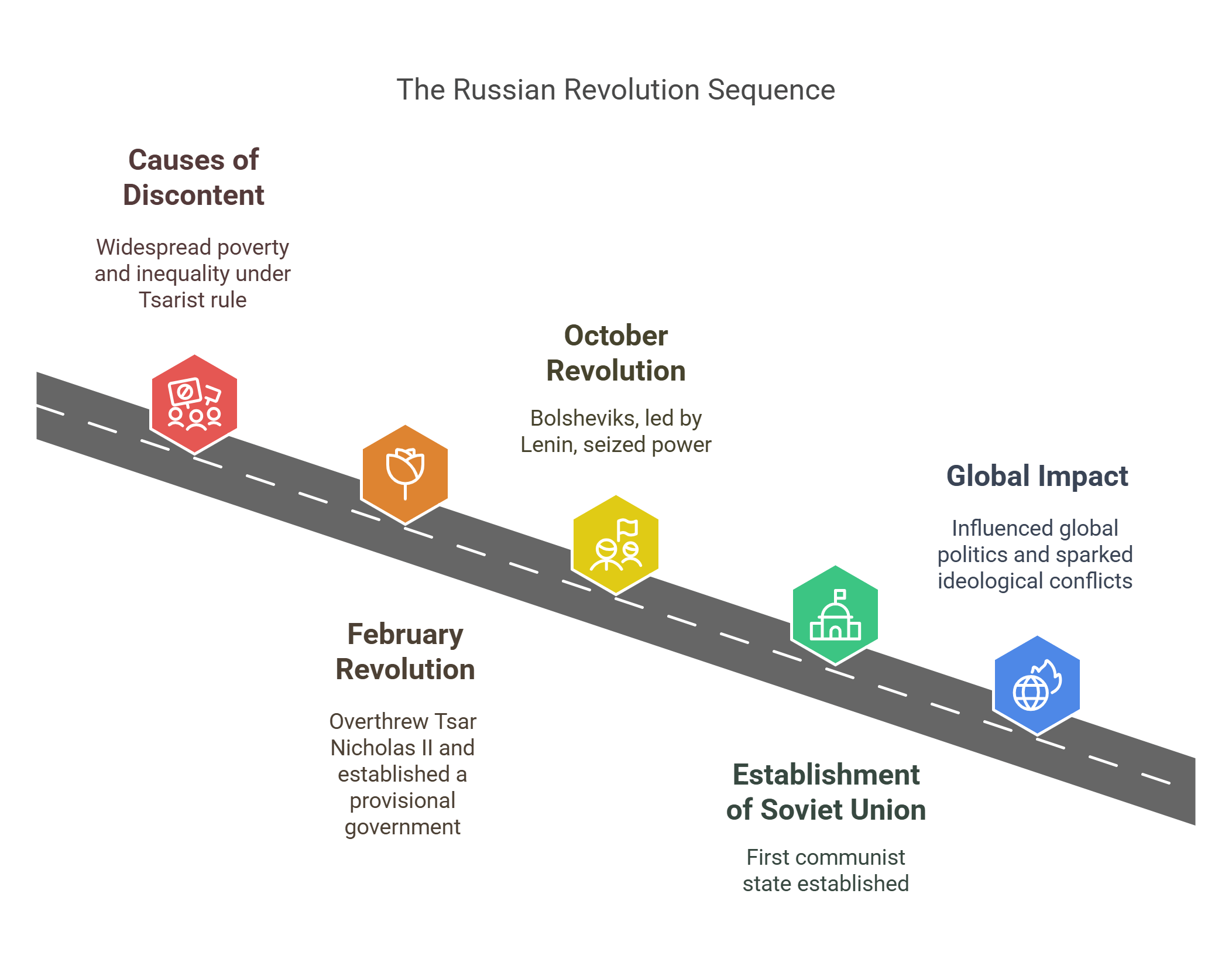
5. Green Revolution
The Green Revolution (1940s–1970s) was an agricultural transformation that increased food production through advanced technologies, including high-yield crop varieties, chemical fertilizers, and irrigation systems.
- Key Innovations:
- Hybrid seeds for wheat, rice, and maize.
- Chemical pesticides and fertilizers.
- Mechanized farming and irrigation infrastructure.
- Impact:
- Prevented famines and improved food security in developing countries like India and Mexico.
- Boosted economic development in rural areas.
- Led to environmental issues, such as soil degradation and pesticide pollution.
Example: The introduction of high-yield wheat in India during the 1960s significantly reduced hunger.
Explained Simply: The Green Revolution was like supercharging agriculture to feed a growing world.
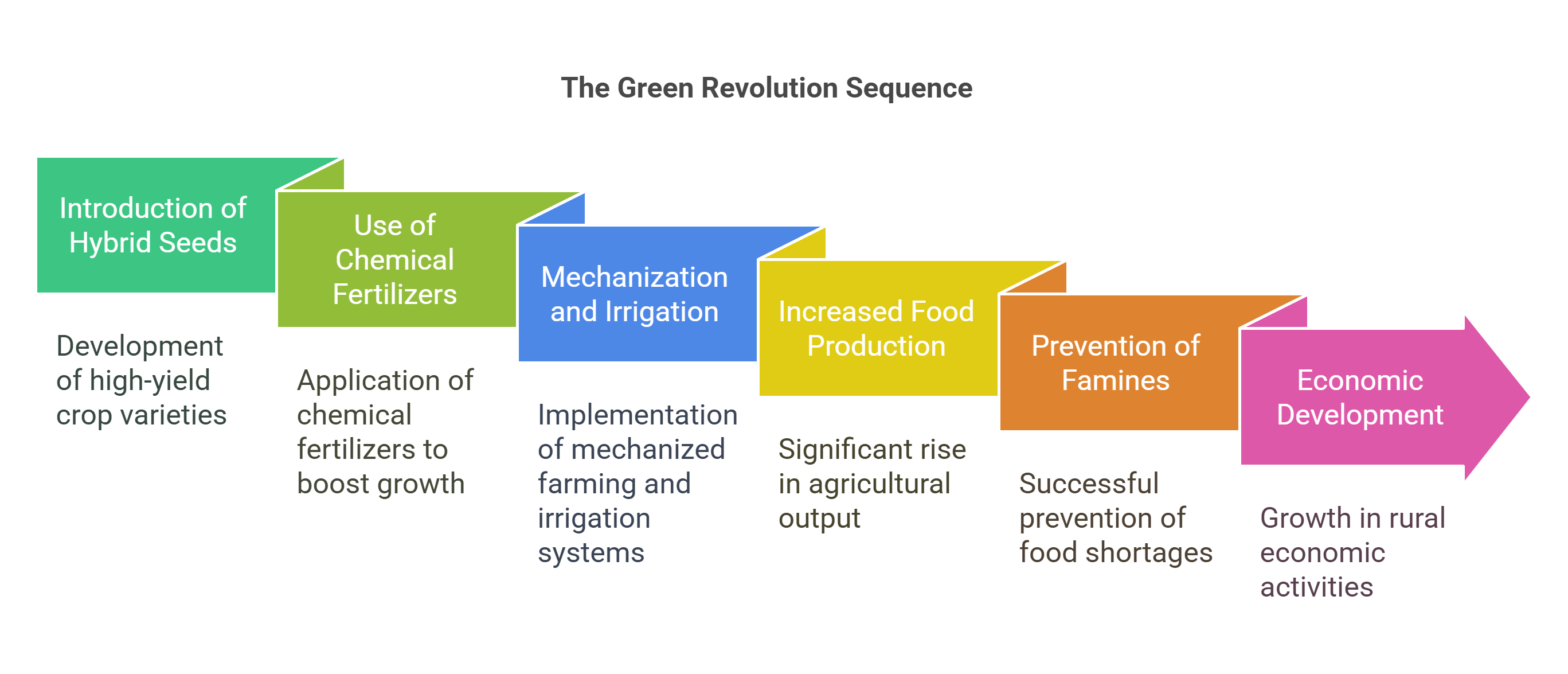
6. Digital Revolution
The Digital Revolution, beginning in the mid-20th century, marks the shift from analog and mechanical technologies to digital systems powered by computers and the internet. It transformed communication, information processing, and nearly every aspect of daily life.
- Key Developments:
- Computers: From mainframes to personal computers and smartphones.
- Internet and World Wide Web: Facilitated global connectivity and information sharing.
- Automation and AI: Streamlined industries through data-driven decision-making.
- Impact:
- Revolutionized communication (e.g., email, social media).
- Transformed economies through e-commerce and remote work.
- Raised concerns about privacy, cybersecurity, and digital divides.
Example: The rise of tech giants like Google, Amazon, and Microsoft exemplifies the economic shift brought by the Digital Revolution.
Explained Simply: The Digital Revolution is like plugging the world into a global information grid, changing how we work, connect, and think.
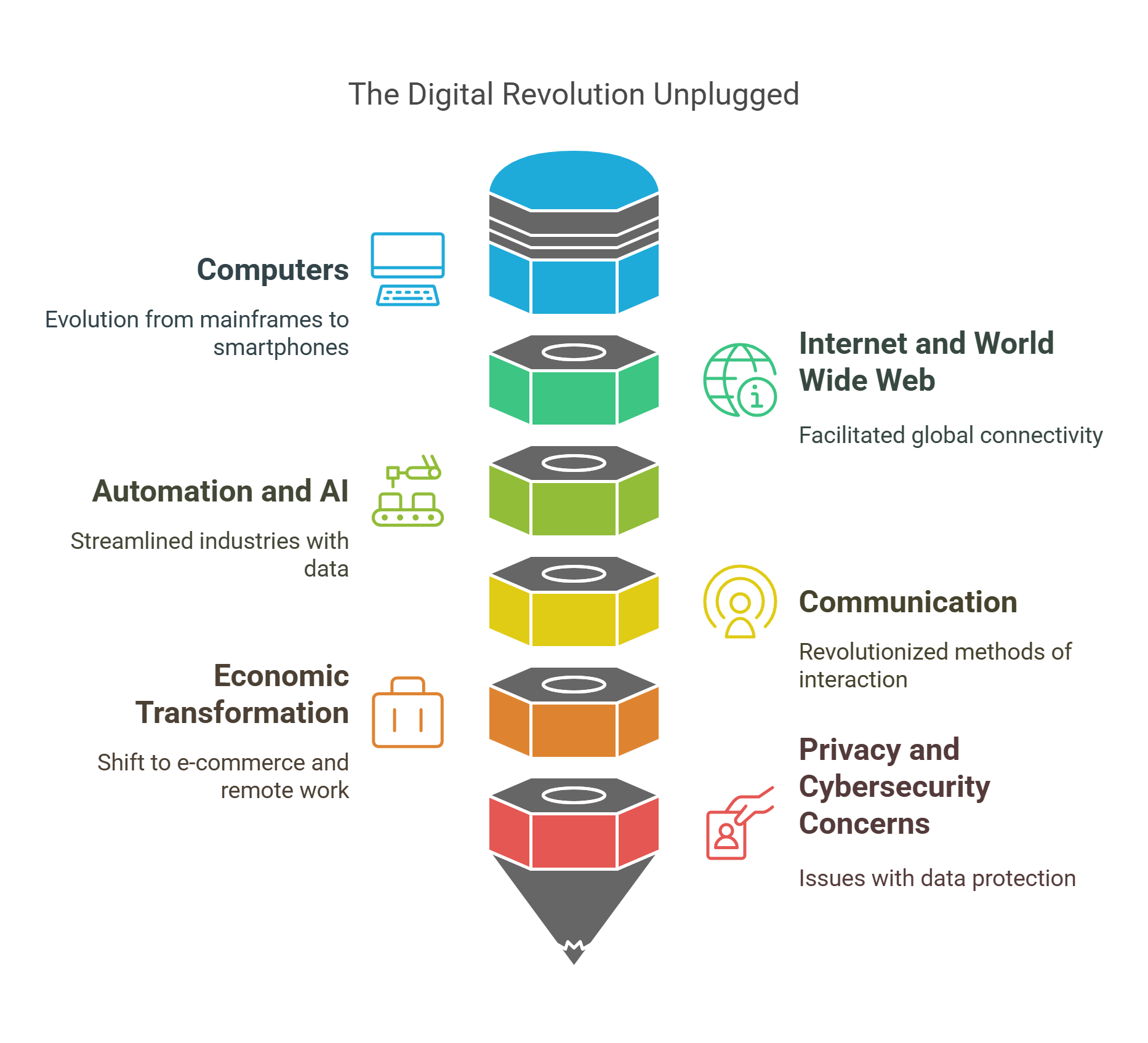
7. Cultural Revolutions
Cultural revolutions are movements that challenge and transform societal norms, values, and artistic expressions. They often coincide with political or economic upheavals, acting as catalysts for broader social change.
- Examples of Cultural Revolutions:
- China’s Cultural Revolution (1966–1976): Led by Mao Zedong, aimed to purge capitalist and traditional elements from Chinese society.
- 1960s Counterculture Movement: In the U.S. and Europe, it challenged traditional values, promoting civil rights, feminism, and anti-war sentiments.
- Impact:
- Redefined art, literature, and popular culture.
- Empowered marginalized groups to demand equal rights.
- Sometimes led to instability and repression (e.g., in China).
Explained Simply: Cultural revolutions are like society rethinking its rulebook, redefining what is acceptable or valued.
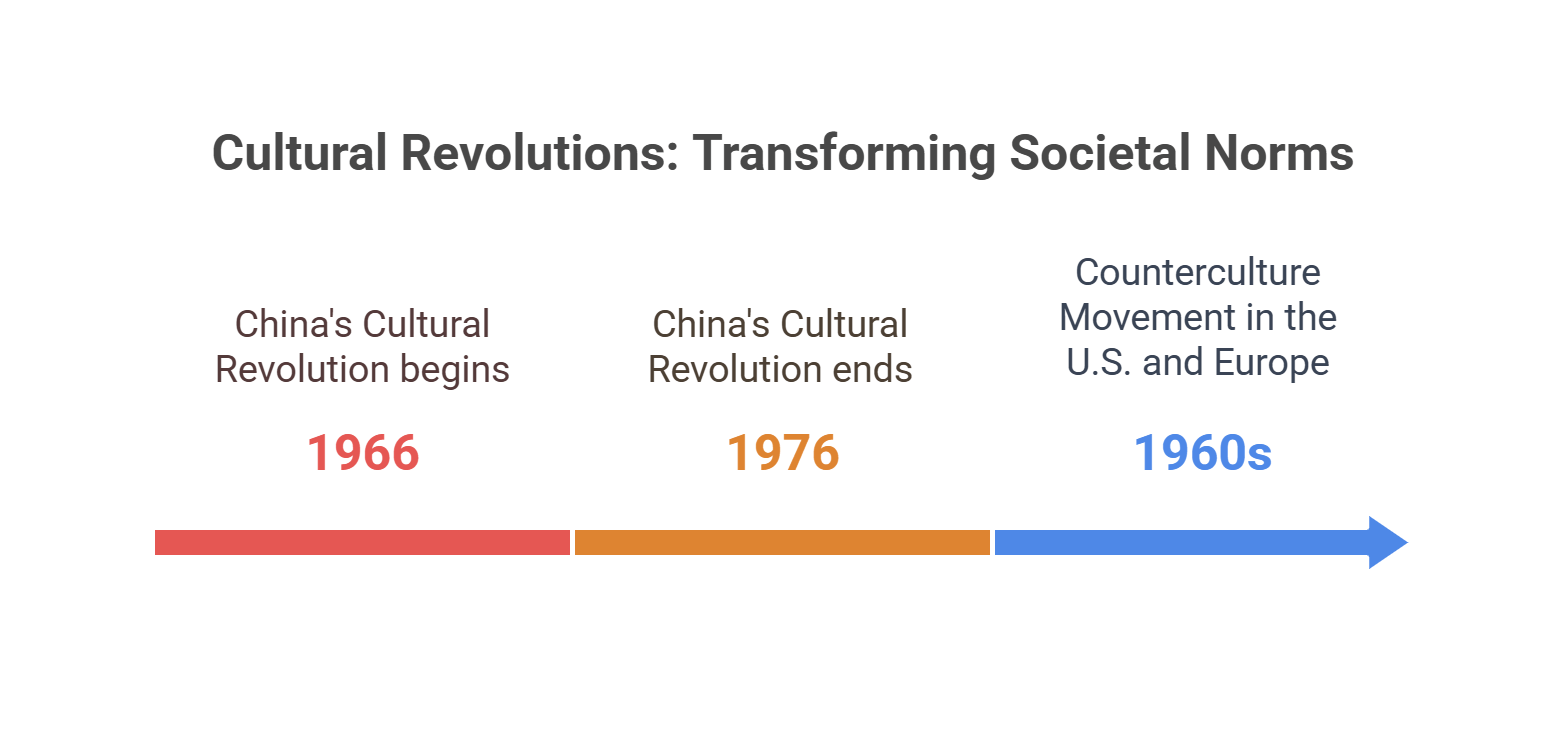
8. Political Uprisings
Political uprisings involve organized resistance against governments or ruling authorities, often triggered by widespread dissatisfaction with inequality, corruption, or oppression. These uprisings may lead to revolutions, reforms, or prolonged conflict.
- Key Examples:
- Arab Spring (2010–2012): A wave of protests across the Middle East and North Africa demanding democratic reforms.
- 1989 Velvet Revolution (Czechoslovakia): A peaceful uprising that ended communist rule.
- Outcomes:
- Some uprisings result in democratic reforms (e.g., Tunisia after the Arab Spring).
- Others lead to authoritarian crackdowns or prolonged instability (e.g., Syria).
Explained Simply: Political uprisings are like shaking the tree of authority, with outcomes ranging from fruitful reforms to bitter chaos.
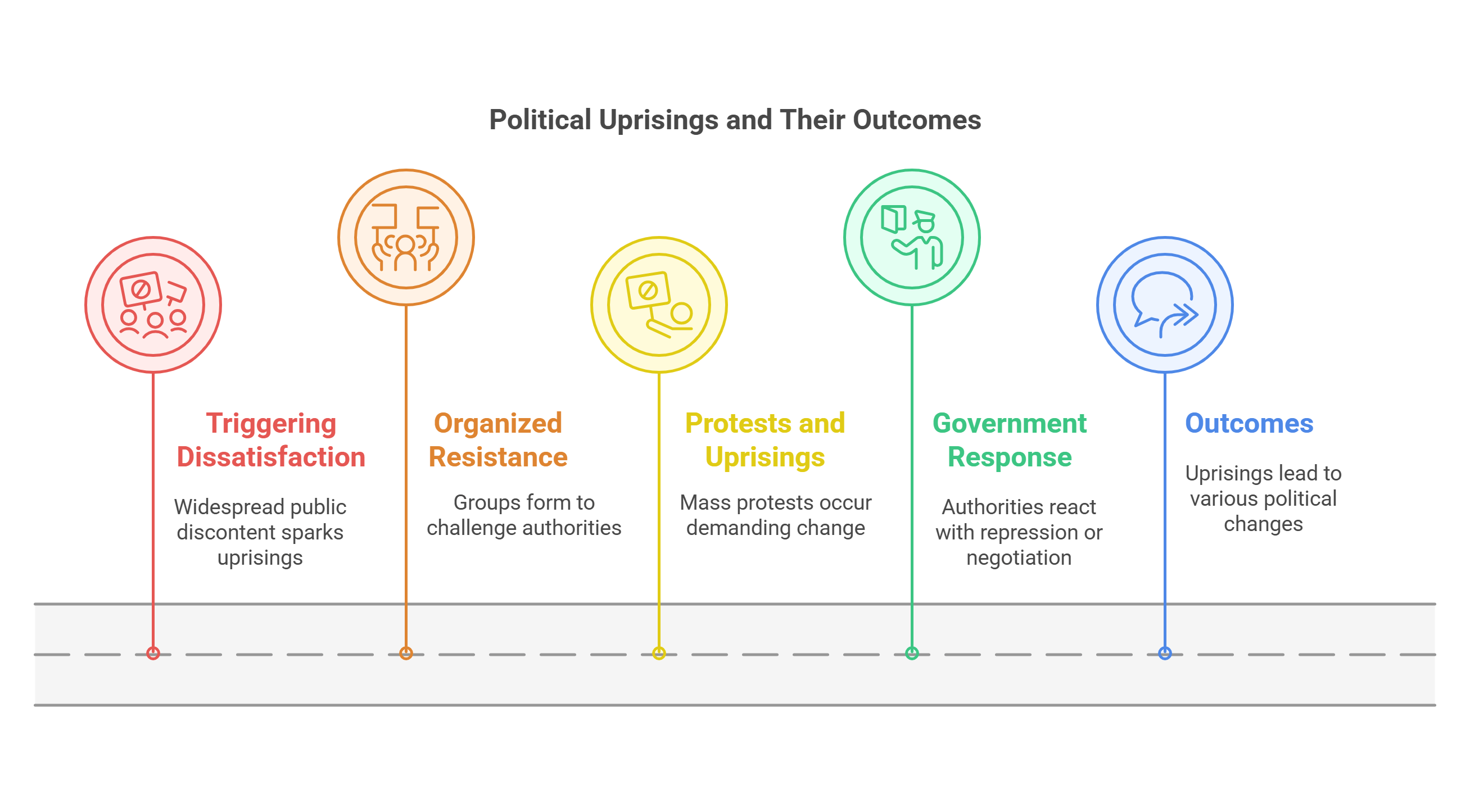
9. Post-Revolutionary Societies
Post-revolutionary societies grapple with rebuilding and restructuring after major upheavals. They face challenges in establishing stability, integrating new governance systems, and addressing lingering divisions.
- Key Challenges:
- Political Stability: Preventing power struggles or authoritarian consolidation.
- Economic Recovery: Rebuilding infrastructure and industries disrupted by revolution.
- Reconciliation: Addressing social divisions and grievances.
- Examples of Outcomes:
- Successes: The U.S. Constitution established a stable democracy after the American Revolution.
- Failures: Post-revolutionary France experienced cycles of instability, including the rise of Napoleon.
Explained Simply: Post-revolutionary societies are like rebuilding after a storm—success depends on addressing the root causes and uniting the people.
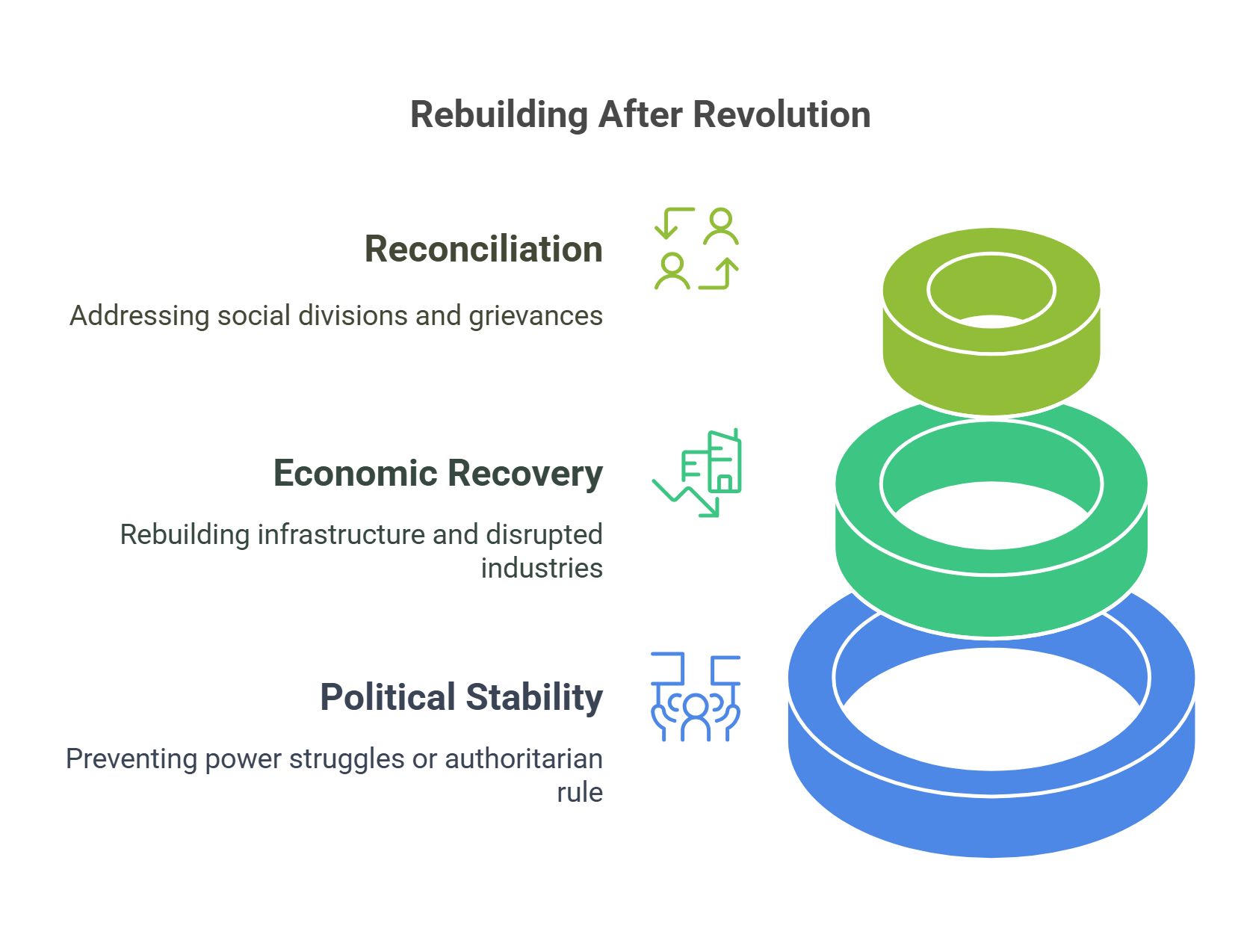
10. Decolonization Movements
Decolonization movements refer to the process through which colonies gained independence from imperial powers, particularly in the 20th century. These movements were often driven by a mix of political activism, armed struggle, and international support.
- Causes:
- Economic exploitation and cultural suppression under colonial rule.
- Influence of global ideologies like nationalism and socialism.
- Post-World War II decline of European powers.
- Key Examples:
- India’s Independence Movement (1947): Led by figures like Mahatma Gandhi, who promoted nonviolent resistance.
- African Independence Movements: Countries like Ghana (1957) and Algeria (1962) fought to end colonial domination.
- Impact:
- Created new nation-states and redefined global political dynamics.
- Left legacies of economic underdevelopment and ethnic tensions.
Explained Simply: Decolonization movements are like colonies breaking free from the chains of imperial rule to reclaim their destiny.
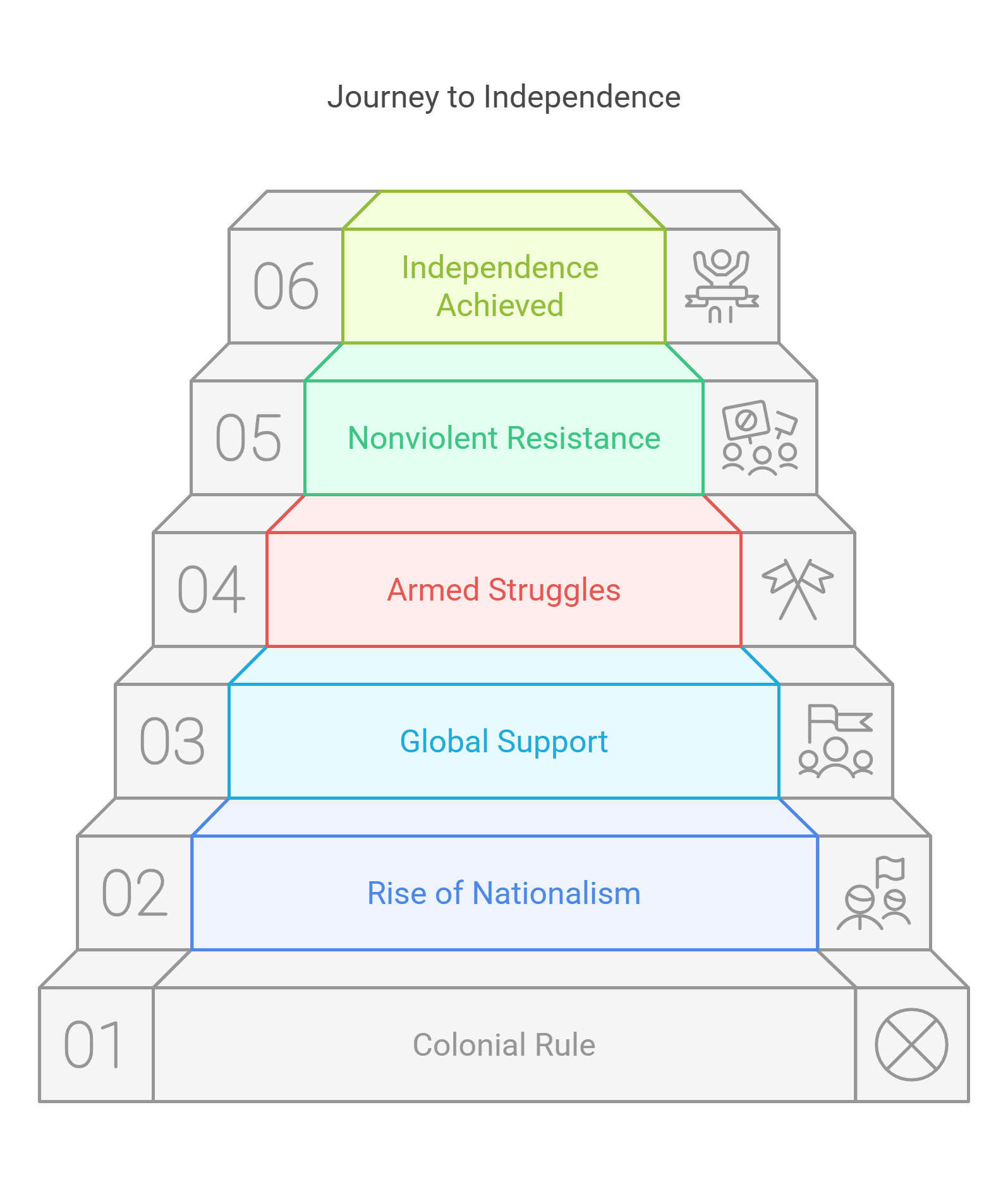
✨ Conclusion
Revolutions represent turning points in history, reshaping economies, societies, and global dynamics. By exploring concepts like the Industrial Revolution, decolonization, and cultural revolutions, readers can critically engage with RC passages and appreciate the profound impact of revolutionary movements on the modern world.
s










